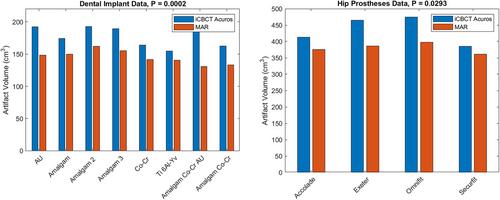The presence of metal implants can produce artifacts and distort Hounsfield units (HU) in patient computed tomography (CT) images. The purpose of this work was to characterize a novel metal artifact reduction (MAR) algorithm for reconstruction of CBCT images obtained by the HyperSight imaging system.
Three tissue-equivalent phantoms were fitted with materials commonly used in medical applications. The first consisted of a variety of metal samples centered within a solid water block, the second was an Advanced Electron Density phantom with metal rods, and the third consisted of hip prostheses positioned within a water tank. CBCT images of all phantoms were acquired and reconstructed using the MAR and iCBCT Acuros algorithms on the HyperSight system. The signal-to-noise ratio (SNR), artifact index (AI), structural similarity index measure (SSIM), peak signal-to-noise ratio (PSNR), and mean-square error (MSE) were computed to assess the image quality in comparison to artifact-free reference images. The mean HU at various VOI positions around the cavity was calculated to evaluate the artifact dependence on distance and angle from the center of the cavity. The artifact volume of the phantom (excluding the cavity) was estimated by summing the volume of all voxels with HU values outside the 5th and 95th percentiles of the phantom CBCT with no artifact.
The SNR, AI, SSIM, PSNR, and MSE metrics demonstrated significantly higher similarity to baseline when using MAR compared to iCBCT Acuros for all high-density materials, except for aluminum. Mean HU returned to expected solid water background at a shorter distance from metal sample in the MAR images, and the standard deviation remained lower for the MAR images at all distances from the insert. The artifact volume decreased using the novel MAR algorithm for all metal samples excluding aluminum (p < 0.001) and all hip prostheses (p < 0.05).
Varian's HyperSight MAR reconstruction algorithm shows a reduction in metal artifact metrics, motivating the use of MAR reconstruction for patients with metal implants.


